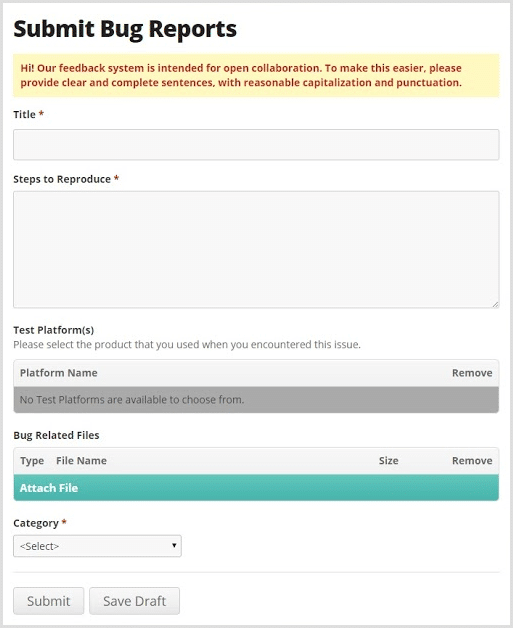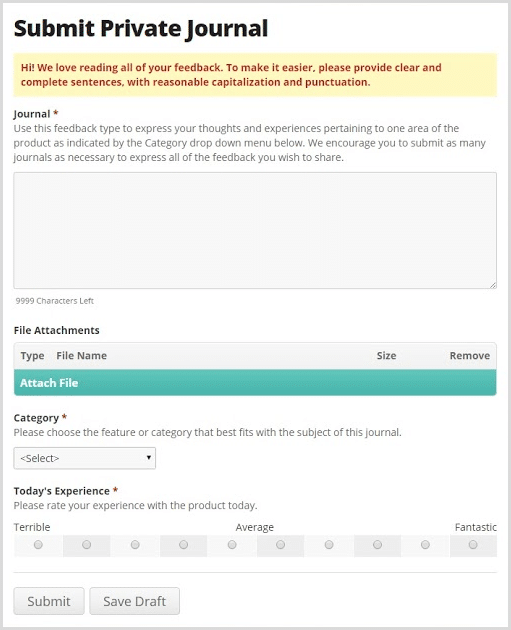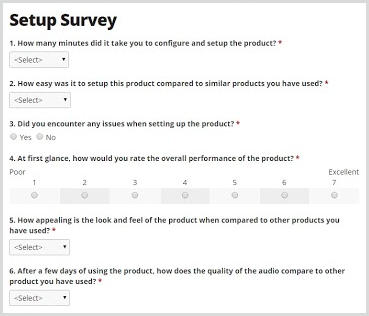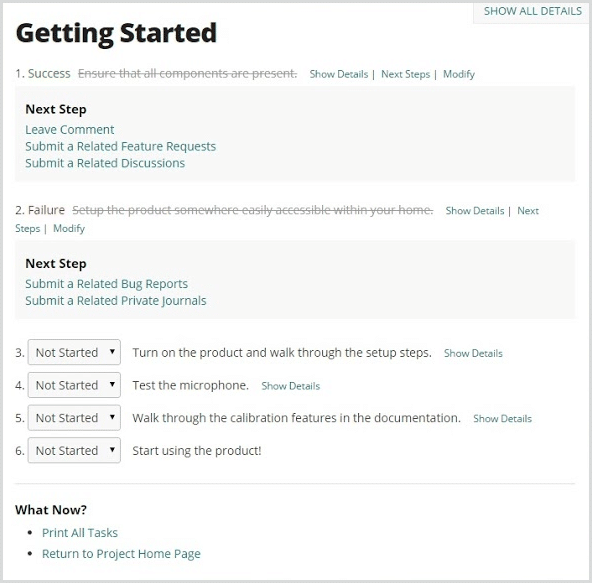7 Types of Feedback You’ll Need to Submit
So, you’ve been selected for a private Betabound Exclusive and you’re about to start testing. Congratulations! You’re excited and eager to begin, but you’re also curious about what you’ll be asked to do throughout the test. There are a number of different tools within the Betabound platform that Beta Managers are likely to ask you to use during the testing phase. This includes bug report forms, feature request forms, private journal entries, and surveys.
Let’s take a look at each of the types of feedback you’ll be asked to give throughout the testing phase of your upcoming beta test (click on the image to enlarge).
1. Bug Reports

A beta product will never be perfect. Finding those critical issues within a product is what beta testing is all about. You’ll want to always remember that you should mention every unique issue that you come across by submitting bug reports. Be descriptive in the title of your bug report and include any/all relevant steps that led you up to the point where you encountered the problem. Beta managers absolutely LOVE when testers also attach screenshots, logs, video, or audio of the issue.
2. Feature Requests

Use feature request forms to dream big! Developers are eager to hear what features you feel are missing and/or what features you’d like to see added to the product to make it even better. You can also use feature request forms to mention features that you’d like to see changed or even removed from the product. Think of it this way: if you were building this product yourself and the sky was truly the limit, what would you include to make this product even more awesome than it already is? Remember, you don’t want to confuse feature requests with bug reports. These are just for you to share suggestions with the developers or add comments to other testers’ ideas, not report problems.
3. General Discussion Forums
General discussion forums are a great way to simply banter with other testers about everyone’s overall experience during the test. You can think of these discussions as a place to just hang out with fellow testers and share thoughts. It’s very casual. You can even ask for (and receive) support from other testers and the beta managers using these forums if you’re running into problems, so don’t hold back. Everyone’s opinion matters, and we appreciate anything and everything you have to share here.
4. Private Journals

Along with general discussion forums, Beta Managers also want to hear about your day-to-day experiences with the product. This is where journal entries come in handy. Journal entries are a private way to share how you’re using the product with the development team. Remember to be honest and direct with these journal entries. You’re also welcome to reference the problems you’ve come across in these entries, but you don’t want to forget to also fill out a bug report form.
5. Surveys

Surveys are the developers’ chance to get quantifiable data about your experiences and opinions of the product, so it’s important that every tester fill out each survey so they get a complete picture. You’ll see surveys pop up throughout the test, and it’s important that you fill them out promptly. Even if your unit isn’t working properly (as beta units tend to do), fill the survey out to the best of your ability.
6. Tasks

We ensure that every single part of the product is tested during beta by using task lists. These are lists of the necessary activities that we need every tester to complete. Afterwards, you’ll report back on whether you could complete the tasks successfully. This ensures that the entire product and all of its features have been through the wringer. It’s important that you complete these tasks as soon as possible, so that the developers can get the data they need and react accordingly.
7. Collaborate and Comment
Betabound is designed to be a collaborative environment. If another tester has reported a similar issue or submitted similar feedback, then the portal will come up with a predictive match. If this happens to you, then you’ll have the chance to add your comments and share any additional details you think may help developers get to the bottom of it. You’ll even see a little “me too” icon where you can cast your vote or show that you ran into the same problem. Remember, the more information the developers have about the bug and who’s running into it, the better. Including screenshots, log files, and describing how you encountered issue will make a huge difference in getting it solved.
We know that all this feedback might sound like a lot, but if you understand how each of these tools work, you’ll find that they’re all really simple and straightforward. The most important thing to remember is to simply remain active and engaged throughout the test. Ask questions if you have them, and don’t be afraid to speak up. Again, these tools are intended to keep everyone on track and help the development team get the feedback they need in order to smooth out the kinks and release a product that will not disappoint its customers.
Any advice for other testers about making the most of these forms and tools? Feel free to share your thoughts in the comments below!
Tags: beta test tools, beta tester feedback, beta tester responsibilities, feedback tools for beta, giving feedback during a beta test, types of feedback during beta